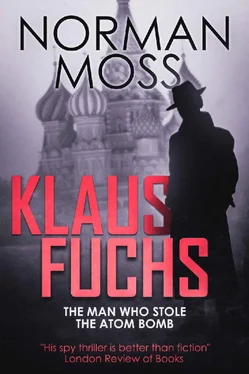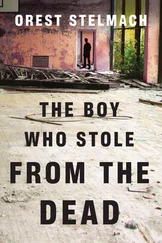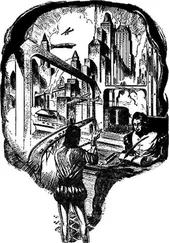Norman Moss - Klaus Fuchs - The Man Who Stole the Atom Bomb
Здесь есть возможность читать онлайн «Norman Moss - Klaus Fuchs - The Man Who Stole the Atom Bomb» весь текст электронной книги совершенно бесплатно (целиком полную версию без сокращений). В некоторых случаях можно слушать аудио, скачать через торрент в формате fb2 и присутствует краткое содержание. Город: London, Год выпуска: 2018, ISBN: 2018, Издательство: Sharpe Books, Жанр: История, Биографии и Мемуары, на английском языке. Описание произведения, (предисловие) а так же отзывы посетителей доступны на портале библиотеки ЛибКат.
- Название:Klaus Fuchs: The Man Who Stole the Atom Bomb
- Автор:
- Издательство:Sharpe Books
- Жанр:
- Год:2018
- Город:London
- ISBN:978-0-31201-349-3
- Рейтинг книги:3 / 5. Голосов: 1
-
Избранное:Добавить в избранное
- Отзывы:
-
Ваша оценка:
- 60
- 1
- 2
- 3
- 4
- 5
Klaus Fuchs: The Man Who Stole the Atom Bomb: краткое содержание, описание и аннотация
Предлагаем к чтению аннотацию, описание, краткое содержание или предисловие (зависит от того, что написал сам автор книги «Klaus Fuchs: The Man Who Stole the Atom Bomb»). Если вы не нашли необходимую информацию о книге — напишите в комментариях, мы постараемся отыскать её.
Klaus Fuchs: The Man Who Stole the Atom Bomb — читать онлайн бесплатно полную книгу (весь текст) целиком
Ниже представлен текст книги, разбитый по страницам. Система сохранения места последней прочитанной страницы, позволяет с удобством читать онлайн бесплатно книгу «Klaus Fuchs: The Man Who Stole the Atom Bomb», без необходимости каждый раз заново искать на чём Вы остановились. Поставьте закладку, и сможете в любой момент перейти на страницу, на которой закончили чтение.
Интервал:
Закладка:
He was among old colleagues and friends. Some of these were there when he arrived, others came soon after him. Otto Frisch came as head of the Nuclear Physics Division; a keen pianist, Frisch tried to persuade Fuchs to play the violin with him, but Fuchs protested that he was out of practice. Egon Bretscher also came from Los Alamos; he would replace Frisch as division head when Frisch moved to Cambridge University. There were seven people from Los Alamos at Harwell.
Another old acquaintance filled in as head of the Theoretical Physics Division until Fuchs arrived, and served as his deputy afterwards. This was Oscar Buneman, who had been in the internment camp in Canada with him. He and Buneman were among the small minority of German refugees in the camp who were not Jewish. Buneman, who was to become a good friend of Fuchs at Harwell, had distributed anti-Nazi leaflets as a student in Hamburg during the early years of the Hitler regime, and spent a year in prison as a result; after this, at the urging of his anxious parents, he went to Manchester University to continue his studies and he remained in Britain. During the war, he worked on the electromagnetic separation of uranium at the Berkeley, California, branch of the atomic bomb project, and then in the Montreal laboratory. Herbert Skinner also came back from Berkeley, to be the head of the General Physics Division (there was some arbitrariness in the distinctions drawn between the work of the different divisions) and later deputy to Cockcroft. He and Fuchs had known each other slightly at Bristol University before the war. Skinner and his wife Erna were to become Fuchs’s closest friends at Harwell.
A lot of people wanted to work at Harwell. The new field of atomic energy seemed to have almost unlimited possibilities. Scientists here would have greater resources for research than any university or industrial laboratory could command. The pay was at civil service rates, slightly higher than academic salaries. Scientists, and particularly those who had worked on the atomic bomb, were attracted also by the prospect of developing atomic energy to help mankind; it seemed to be the fulfilment of the alchemist’s dream of turning base metal into something of incalculable value. Margaret Gowing, the official historian of the British atomic energy programme, wrote of those early days at Harwell:
‘Most people remember a strong sense of idealism, which expressed itself not only in a belief in internationalism and international atomic energy control but also in a desire to do something to demonstrate the peaceful uses of atomic energy as a counter-balance to the bomb. There was a belief that a whole new world would open up before them — a medical revolution through the use of radioactive isotopes, and a new and clean source of power which would end the pall of sulphurous smoke over the cities.’ [12] Margaret Gowing, Independence and Deterrence: Britain and Atomic Energy, 1945-52.
Fuchs himself wrote to his father shortly before coming to Harwell: ‘I only hope that we can concentrate on the peacetime use of this tremendous force in the future.’
The work at Harwell was exciting because everything that was being done there was new. Never before had nuclear physics been an applied science. The design of an atomic reactor, the extraction from one of heat and power, the hazards of radiation and how to protect against them, the production and use of radioactive materials — all these were entirely new areas of investigation. Every scientist working there was breaking new ground. Some of the ideas going around seem today to be almost laughably primitive: for instance, people working at Harwell were given extra milk rations because it was believed that this strengthened their bones against the harmful effects of radiation.
Harwell shared with the rest of Britain a sense of optimism, a feeling that a new and better world was coming now that the long war was over. Britain alone among the nations had fought the war from the beginning and won through, and now she seemed to be following at home a policy of fair shares for all. British people on the whole were pleased with themselves. But there was little joy in the surroundings. In those immediate postwar years strict rationing was still in force, of clothes and fuel as well as food. The streets were gloomy, because street lighting was limited and shop window lighting was banned, weeds grew on the untended sites of bombed buildings, pubs were short of drink, restaurants were short of food, and homes were usually cold.
In those early days at Harwell, there were pioneer conditions to match the pioneering spirit of the scientists: muddy roads, inadequate housing and working conditions, and an occasional question mark over heating and water supply. The laboratories were set up in the RAF hangars, as was, later, the first research reactor. The chemists sometimes used milk bottles as beakers, and they used to pour their sludge down the toilets because these were the only drains that worked.
When Fuchs arrived he lived for a time at Ridgeway House, which had been the RAF officers’ quarters; most scientists and their families lived there at first, because there was no other accommodation for them. Like most officers’ quarters of the period, it was designed to give the residents an elevated sense of social status: ivy covered the front of the building, and inside, wooden floors, gleaming with polish, and shiny leather armchairs contributed to the country manor atmosphere. Ridgeway House is still a part of Harwell today.
After a while, rows of prefabricated houses were put up, ugly, box-like but serviceable bungalows, each with three rooms plus kitchen and bathroom, and families moved into these as they were finished — there were 200 eventually. Lawns were created early on at Harwell, and beds of flowers planted at strategic places: roses and chrysanthemums, dahlias and zinnias formed patches of gaiety in the bleakness. Rows of young trees were planted along the edge of the airstrip as a windbreak.
Harwell is within easy reach of Oxford and London, but most people did not have cars in the first years and bus services in the area were infrequent and did not run late in the evening, so life at Harwell was quite isolated. In this as in many other respects, Harwell resembled Los Alamos. There was the same close-knit community, the same intermingling of social and professional life, the same dependence on a bureaucracy for the necessities, the same strong commitment to the work and the same exciting newness about it. But there were also marked differences for those coming from Los Alamos, particularly when they looked outside the laboratories, whether one considered the landscape, comparing the close horizons and little fields around Harwell with the spectacular vistas and plunging canyons around Los Alamos, or looked at the narrow winding lanes, or 1940s ration-cramped meals. In those years, life in Britain was more limited than life in America, and young Englishmen, the kind who came to work at Harwell, had less money to spend than Americans, ate less, and wore tighter-fitting clothes of heavier material.
The lawns and flower beds at Harwell were the distinctive contribution of the director, John Cockcroft. He was keen on gardens, and he hired a landscape gardener who had been in the Royal Family’s employ. Cockcroft was the physicist who, with E. T. S. Walton, split an atom artificially for the first time, in 1932, in the Cavendish laboratory in Cambridge, an achievement for which they were awarded a Nobel prize nineteen years later. At Harwell, Cockcroft lived with his family in what had been the RAF base commander’s house, one of the few houses on the site.
His love of gardens was of a piece with the Englishness of his character. He was quiet-spoken, modest and retiring, and kept his thoughts and feelings to himself. He would go to great lengths to avoid conflict, like the conventional Englishman for whom the horror to be avoided at all costs is a ‘scene’. Sometimes, staff members would want him to adjudicate a dispute and would be rewarded only with some delphic utterance and go away frustrated. In those early days, Cockcroft involved himself and took decisions in every area of Harwell life, from the scientific experiments to the purchase of equipment to arrangements for housing and even laundry. He inspired loyalty in his staff, and helped to create the strong group loyalty to Harwell as an institution that developed there. Fuchs, for one, looked up to him and admired him.
Читать дальшеИнтервал:
Закладка:
Похожие книги на «Klaus Fuchs: The Man Who Stole the Atom Bomb»
Представляем Вашему вниманию похожие книги на «Klaus Fuchs: The Man Who Stole the Atom Bomb» списком для выбора. Мы отобрали схожую по названию и смыслу литературу в надежде предоставить читателям больше вариантов отыскать новые, интересные, ещё непрочитанные произведения.
Обсуждение, отзывы о книге «Klaus Fuchs: The Man Who Stole the Atom Bomb» и просто собственные мнения читателей. Оставьте ваши комментарии, напишите, что Вы думаете о произведении, его смысле или главных героях. Укажите что конкретно понравилось, а что нет, и почему Вы так считаете.












